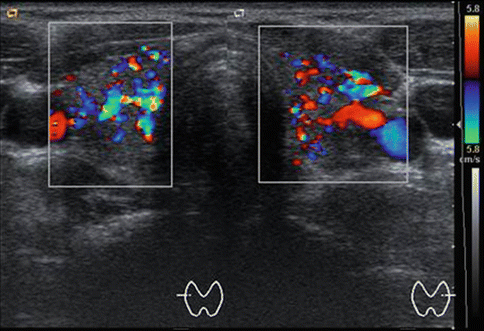Fig. 6.1
A case of ophthalmopathy related to Graves’ disease
6.2 Diagnosis
Once the question of thyrotoxicosis has been raised by clinical history and patient’s examination, laboratory data are required to verify the diagnosis, help estimate the severity of the condition, and assist in planning therapy. Hyper-thyroidism is confirmed when a suppressed thyrotropin (TSH) level (i.e., <0.1 mUI/L) is found in the face of an elevated free thyroxine (FT4) level. However, 10 % of patients will have an increased total or free triiodothyronine (FT3) level in the face of a normal FT4 and suppressed TSH level, a condition termed “T3 toxicosis.” Antibodies to thyroglobulin (TgAb) and thyroid peroxidase (TPOAb) may be present but are not diagnostic. Although TSH receptor antibodies (TRAb) are present in the sera of almost all patients with Graves’ disease, their measurement is should be restricted to selected cases (i.e., unclear diagnosis, euthyroid ophthalmopathy, risk of transient neonatal hyperthyroidism) [3].
Thyroid ultrasound shows a reduced echogenicity and heterogeneous echotexture, generally without nodularity (Fig. 6.2), associated with a significantly increased thyroid blood flow at color and power Doppler examination (Fig. 6.3).



Fig. 6.2
Ultrasonographic (US) findings in a female patient with Graves’ disease in axial (a) and longitudinal (b, c) projection. US shows enlarged thyroid lobes with diffusely heterogeneous echotexture

Fig. 6.3
Doppler ultrasonography findings in a patient with Graves’ disease showing increased vascularization in both thyroid lobes
Thyroid scan with either 99mTc-pertechnetate (Figs. 6.4 and 6.5) or 123I (Fig. 6.6) demonstrates homogeneously increased uptake and easily discriminates Graves’ disease from other causes of hyperthyroidism such as nodular autonomy (i.e., focally increased uptake), subacute thyroiditis, or iodine overload (depressed uptake) [4].
 < div class='tao-gold-member'>
< div class='tao-gold-member'>





Only gold members can continue reading. Log In or Register to continue
Stay updated, free articles. Join our Telegram channel

Full access? Get Clinical Tree


